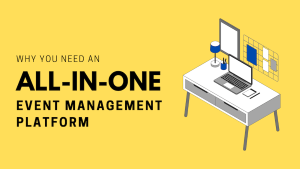
The academic conferences run on abstracts. These are brief proposals that determine who speaks, what gets discussed and which research reaches the broader community. When the system for managing them breaks down, everything else falls apart. Deadlines get missed and even the most potent submissions slip through review cracks.
The old methods of managing academic conference content no longer work and the cracks have begun to show up wider every year. All of these challenges and more mean that some promising research might never make it to the stage. This is a tribulation that the modern abstract management system attempts to solve.
Before you choose the right system for you, it is important to know what features matter and which ones just sound good in marketing copy. In this article, let’s go over the 10 non-negotiables in a modern abstract management system.
1. A Submission Process That Works For All
The submission process sets the tone for everything that follows. When researchers struggle to submit their abstracts, they give up or submit elsewhere. A good system makes this effortless. Researchers should be able to create an account, fill in their details and upload their abstract without consulting a manual or watching tutorial videos.
Forms need to be intuitive. Questions should appear in logical order. File upload requirements must be crystal clear from the start. Many systems fail here by asking for information that could be collected later or requesting formats that most researchers don’t have readily available. The result is abandoned submissions and frustrated academics who never complete the process.
2. Review Workflows That Bend Without Breaking
Review committees operate differently across disciplines and organizations. Some prefer blind reviews where author information stays hidden. Others demand full transparency. A modern and capable model is one that will adapt to and accommodate all of these approaches. The workflow must not force organizers to fold into what is an otherwise one-size-fits-all model.
Configurable review criteria matter tremendously. A scientific conference values the methodology and innovation above all else, while an academic gathering may value information dissemination more. Therefore, reviewers working as part of these events will benefit from personalization. Generic rating scales, as their name suggests, only produce generic, bland results and for the major part, fail to catch the nuances that separate exceptional submissions from merely acceptable ones.
3. Visibility To End the Waiting Game
Uncertainty leads to anxiety. Researchers who turn in their abstracts are no exception to this universal, human truth. These individuals, who have poured their blood, sweat and tears into building their abstracts, hope to know where their submission stands. Hence, conference organizers need something much larger than even a bird’s-eye view. Event planners need to oversee the entire process, beginning from submission all the way through final acceptance, also accounting for everything that arises in between.
Dryfta’s dashboard interface displays this information at a glance. Color-coded statuses, progress bars and deadline countdowns help everyone understand what needs attention right now. When a researcher logs in, they immediately see whether their abstract is under review, requires revisions or has been accepted. This system lets researchers know when their abstract has entered review.
4. Communication That Stays Where It Belongs
Email threads about abstract submissions quickly become impossible to manage. Messages sometimes get lost and the context is tough to catch up on. Multiple stakeholders reply to different threads about the same submission. Modern abstract management systems successfully solve this by centralizing all communication within the platform itself.
Internal messaging tied to specific abstracts keeps conversations organized and searchable. When a reviewer has questions about a submission, they ask directly through the system. The author receives the question, responds through the same interface and the entire exchange remains attached to that abstract permanently. Six months later, anyone can review the conversation history and understand exactly what happened.
5. Search Functions To Find What You Need Easily
Conference organizers need to find specific abstracts quickly. Searching by author name or keyword helps, but barely scratches the surface. Modern systems offer layered filtering that lets organizers slice the submission pool dozens of different ways.
Topic categorization allows filtering by research area, methodology or application domain. Submission status filters surface abstracts that need immediate attention or identify patterns in acceptance rates. Author institution searches help organizers understand geographic diversity in their submissions. Combining multiple filters reveals insights that would otherwise remain buried in spreadsheets.
6. Data To Tell What’s Really Happening
Data drives better decisions but only when it’s accessible and interpretable. Modern abstract management systems generate reports that reveal patterns and trends across submission cycles.
Submission timeline analytics show when abstracts arrive. Most conferences receive a barrage of submissions right before the deadline. Understanding this pattern helps organizers plan review schedules and set realistic timelines. Comparing submission volumes year over year reveals whether outreach efforts are working or if interest is declining.
7. Systems That Can Talk to Each Other
Abstract management systems don’t operate in isolation. They need to connect with registration platforms, scheduling tools, email marketing services and payment processors. Manual data transfer between systems introduces errors and wastes time.
API access allows seamless data flow between the abstract management system and other conference infrastructure. When an abstract gets accepted, the system can automatically trigger a registration invitation. Speaker information flows into scheduling tools without manual reentry. Presentation titles and author names populate the conference website and mobile app directly from the management system.
8. Access From Anywhere That Matters
Researchers work from everywhere. Reviewers evaluate submissions during commutes, between meetings or while traveling. Conference organizers check submission status from their phones. Systems that only work properly on desktop computers create unnecessary barriers.
Offline capability for reviewers makes work possible even without internet connectivity. Downloading assigned abstracts and evaluation forms allows reviewers to work during flights or in areas with poor connectivity. When they reconnect, scores and comments sync automatically with the central system.
9. Protection That Keeps Research Under Wraps
Academic research often involves sensitive or proprietary information before publication. Abstract management systems hold data that researchers haven’t publicly shared yet. Protecting this information is not optional.
Encryption for data at rest and in transit prevents unauthorized access. Role-based permissions ensure that reviewers only see abstracts they’re assigned and can’t access author information when blind review is active. Audit logs track who accessed what information and when, providing accountability and helping organizers investigate potential security issues.
10. Growth That Doesn’t Demolish Everything
Small conferences managing 50 abstracts have different needs than major events handling 5,000 submissions. The best systems work equally well at both scales without requiring different pricing tiers or feature sets.
Growth accommodation means the system supports conferences as they expand over time. An event that started with 100 attendees might grow to 1,000 over several years. The abstract management system should scale without requiring migration to a different platform or extensive reconfiguration.
Making the Choice to Use A Modern Abstract Management System
The features that matter for an abstract management system depend on conference size, discipline and organizational structure. The core requirements, however, remain consistent: make submission easy, make review efficient and make data accessible.
Conference organizers evaluating abstract management systems face a crowded market saturated with bold promises. Vendors claim their platforms revolutionize the submission process and make reviews effortless. Many of these claims sound identical until organizers dig deeper and request live demonstrations with real data. The right choice comes down to matching system capabilities with actual needs rather than theoretical features that sound impressive but never get used in practice.
At Dryfta, we have spent years building an abstract management system that delivers all these promises. To learn more, please visit our website or sign up for a free demo today.




